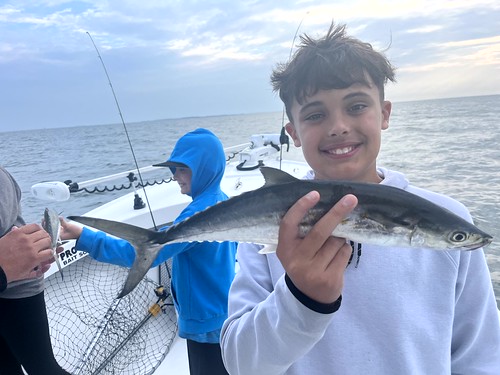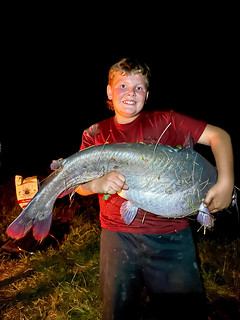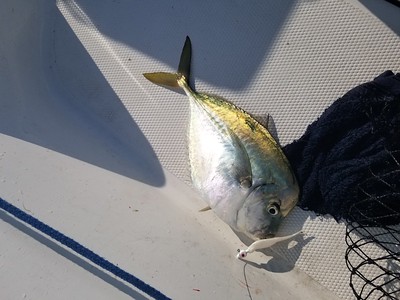Maryland Fishing Report – August 23

This young angler caught a Spanish mackerel, photo by Travis Long
As we approach the end of August, fishing in Maryland could hardly be better, so be sure to get outside with friends and family.
The Maryland Department of Natural Resources has developed an online striped bass habitat conditions mapping tool on our website, applying newly developed water temperature and dissolved oxygen-based thresholds for Maryland’s resident striped bass. This tool will help you identify current conditions at your local fishing hotspots so you can fish at the most suitable locations.
Forecast Summary: August 23 – August 29:
Shorter days and recent rains have continued to cool Chesapeake Bay surface waters. The upcoming week will provide us a combination of sunny days and cooler nights with a chance of thunderstorms on Thursday, Friday, and Tuesday. These conditions should keep water temperatures stable near 80 degrees. The coolest main Bay surface waters are now found between the Patapsco River and Conowingo Dam.
Bay salinity is still above average. Oxygen conditions are slightly better below Bloody Point to the state line, with most places recording suitable fishing depths down to at least 35 feet. In the area from Tolchester to the Bay Bridge, avoid fishing below about 20 feet. Check the areas of low oxygen map to help determine the maximum fishing depth in your favorite area.
Expect average flows all week. However, due to recent rains in Pennsylvania, Susquehanna River flows at the Conowingo Dam will remain elevated this week. There will be above average tidal currents Sunday through Tuesday as a result of the upcoming full moon August 31. Expect average clarity in Maryland’s waters. To see the latest water clarity conditions, check Eyes on the Bay Satellite Maps.
As always, the best fishing areas could be further refined by intersecting them with underwater points, hard bottom, drop-offs, and large schools of baitfish.
For more detailed and up-to-date fishing conditions in your area of the Bay, be sure to check out Eyes on the Bay’s Click Before You Cast.

Joey Davis wrestled this brute of a blue catfish from the Chester River recently. Photo by Lora Davis
At the Conowingo Dam pool, anglers routinely gather at dawn to enjoy striped bass fishing by casting topwater lures, paddletails, and jerkbaits. Others enjoy wading in the lower Susquehanna River or fishing from small boats and kayaks and casting the same lures during the early morning and evening hours.
The most productive striped bass fishing is focused near the mouth of the Patapsco River. Using spot for live-lining is the most popular way to fish the area between the mouth of the river offshore of Fort Howard Park and Sparrows Point and near the Key Bridge up to Fort Carroll. The best fishing success occurs in the morning when a good tide is running. Fishing there tends to be a bit crowded.
Anglers are also enjoying some fun fishing action for striped bass by casting topwater lures, jerkbaits, and paddletails near the commercial piers and old piling fields in Baltimore Harbor. Anglers are also finding spot for live-lining within Baltimore Harbor and Curtis Creek.
Fishing for a mix of spot and white perch is good in most of the region’s tidal rivers and out on several reefs and knolls in the Bay. Pieces of bloodworm on a bottom rig is the most popular way to fish for these two species in deeper waters. To cut costs, anglers can extend their bait inventory by mixing cut-up nightcrawlers in the bloodworm juice that pools on a bait cutting board, or use artificial bloodworm baits.
There are plenty of blue catfish to be found in the upper Bay for anglers fishing from boats or from shore. All it takes is some stout tackle and fresh bait in the form of cut menhaden, white perch, or bluegill sunfish; or use chicken liver or commercially scented baits. The Susquehanna and Chester rivers have large populations of blue catfish, and they can also be found in every tidal river.
Anglers continue to target striped bass during the early morning at the west side of the Bay Bridge by live-lining spot near the 25-foot drop-off edge. A few others are having good luck with cut spot, small white perch, and soft crab baits. The best fishing success occurs during the morning on a running tide, and as the day wears on, the fishing success declines. Casting soft plastic jigs near the bridge pier bases is also a good tactic during the early morning.
Many striped bass anglers are casting topwater lures, jerkbaits, and paddletails along shoreline structure during the early morning. The rocks at Poplar Island, Thomas Point, the area near the Naval Academy, and the shorelines near the mouths of the region’s tidal rivers are just a few good places to fish this way. Anglers report catching a mix of striped bass, speckled trout, puppy drum, and bluefish.
Trolling for striped bass and bluefish along channel edges with small spoons and paddletails behind planers and inline weights at speeds less than 5 knots is a good tactic. Good places to troll include the channel edges of the shipping channel and the false channel, and the eastern edge of the shipping channel from Buoy 83 past the Sharps Island Light.
Trolling at speeds up to 7 knots with small Drone and Clark spoons will attract the attention of Spanish Mackerel. Pulling Gold Clark and multi-colored Drone spoons behind No. 1 planers is the most popular way to fish.
If you’re lucky, diving gulls might show the way to a mix of bluefish and Spanish mackerel. Casting small but heavy flashy metal jigs and Got-Cha lures into the action, allowing them to sink, and then speed-reeling is a great way to catch Spanish mackerel; slower retrieves will allow bluefish to catch up. Always approach the action upwind and drift closer to the breaking fish – a bold and noisy approach will cause fish to sound.
Fishing for white perch continues to provide plenty of summer fun in the tidal rivers and creeks. Fishing off docks and piers with simple bottom rigs baited with grass shrimp, pieces of bloodworm, or peeler crab close to structure is an effective tactic. The Kent Narrows is another great place to fish for white perch from bulkheads or in a boat. Oyster bars in the lower sections of the tidal rivers can also be a great place to target white perch. Spot can also be found on the shallower west end of the Bay Bridge, Whitehall Bay, off Chesapeake Beach, and at the mouth of the Choptank and Little Choptank rivers.
During the morning and evening hours casting small spinnerbaits, roadrunner type lures, and spinners along shorelines of the tidal rivers where rocks, sunken wood, and prominent points will attract white perch. Anglers report that they are also catching undersized puppy drum in the same areas.
Striped bass anglers are now able to fish the lower Potomac River. Anglers are reporting that the best striped bass fishing in Maryland waters is along the shallower shorelines on both sides of the Bay and in the lower sections of the tidal rivers. Most success occurs in the early morning hours before the sun climbs too far above the horizon. Topwater lures in the form of poppers and Zara Spooks provide an exciting way to get in on the action; jerkbaits and paddletails will work well also. Anglers are encountering a mix of striped bass, bluefish, puppy drum, and speckled trout from the waters of Tangier Sound to St. Marys River.

Angler Romeo Casanova caught a 23.5-inch Spanish mackerel in the Chesapeake Bay
Trolling for a mix of Spanish mackerel and bluefish is a popular focus for anglers in the lower Bay. Small multi-colored Drone Spoons and gold Clark Spoons pulled behind No. 1 planers is the most popular trolling spread. Trolling at speeds of 7 knots or better will fit the bill for Spanish mackerel; slower speeds will allow bluefish to catch up.
Anglers who keep their eyes on the horizon may spot diving gulls, indicating breaking fish that are chasing bay anchovies. Approaching on the upwind side and drifting in quietly can set the stage for some fun light tackle casting action for a mix of Spanish mackerel and bluefish. Small heavy and flashy metal jigs or Got-Cha lures cast into the fray can result in hookups.
Large red drum continue to roam the lower Bay and can show up under schools of feeding bluefish and Spanish mackerel, or churning up the bottom near the Mud Leads, the Target Ship, or the Middle Grounds. Once you locate these fish, jigging with large soft plastic jigs is an effective way to enjoy some exciting catch-and-release action. Cobia are being spotted on the surface and casting large soft plastic jigs to them is an excellent way to catch them. Chumming and drifting with live eels to the back of the chum slick is also a popular fishing method.
Fishing for spot continues to be excellent at the mouth of the Patuxent River and Tangier Sound this week. The spot are becoming larger and make for some good eating and fun fishing for all ages. In some areas white perch will be mixed in with small croakers and kingfish.
Recreational crabbers are remarking about the exceptional size of some of the crabs being caught. The numbers may not be excessive but 7-inch and 8-inch crabs are a welcomed addition to anyone’s basket. The larger crabs tend to be coming from waters as deep as 15 feet or so, but they are showing up in shallower waters where crabs that are 5 inches or less tend to dominate. Many crabbers are lamenting that once the sun clears the horizon, crabs are dropping off trotlines before they can be netted. The use of collapsible traps or net rings will solve this problem.
Anglers fishing the upper Potomac River this week are reporting low water conditions typical for the summer months. Although many areas can be difficult to navigate by boat, the opportunity to wade and fish from shore presents itself if anglers are careful. Low flows, clear water, and summer heat dictate long casts with light lines during the earliest morning hours. Getting up that early can bring its rewards with exciting topwater smallmouth bass action. Tubes, grubs, and small crankbaits can extend fishing time after the sun clears the horizon. Current breaks, submerged ledges, and deep-water pockets behind boulders are good places to target.

Evan Paugh holds up two beautiful largemouth bass he caught and released from Deep Creek Lake recently. Photo by Jason Paugh
Fishing for largemouth bass is good in a variety of water environments, from the smallest farm ponds to our largest reservoirs and tidal waters. The summer behavior pattern is much the same wherever largemouth bass are found – feeding during the low-light evening and through the night into early morning in shallow areas where food can be found near grass beds. They then seek cool shade during the heat of the day.
Casting topwater lures in the form of soft plastic frogs, buzzbaits, and poppers near or over shallow grass is always exciting. Jerkbaits, spinnerbaits, and crankbaits work well along the edges of thick grass or spatterdock fields. Thick floating grass over deeper waters can provide shade and dropping wacky rigged worms with sufficient weight to penetrate the grass is a proven tactic. Docks, overhanging brush, and fallen treetops provide shade and flipping wacky rigged stick worms or soft plastics under or near is a good way to target a resting largemouth bass.
Anglers are targeting northern snakeheads in thick grass within the upper reaches of many of Maryland’s tidal rivers. In most waters the snakeheads are still protecting fry balls, or will be nearby. It has been a process for them, and many are starting to get their appetite back, which is improving fishing success. They will attack noisy surface lures out of hunger or if they feel there is a threat to their young. Buzzbaits are a good choice to use for this type of fishing, as are soft plastic frogs.

Christopher Pater sent in this picture of an Atlantic moonfish he caught recently. Photo by Christopher Pater
Surf anglers are enjoying good fishing for a mix of kingfish, spot, bluefish, and flounder during the morning and evening. Bloodworms or artificial bloodworm-scented baits work well for the kingfish and spot. Cut spot or finger mullet can be used to catch bluefish Strips of spot, squid, or Gulp baits are being used for flounder.
At the Ocean City Inlet, sheepshead can be found near the jetty rocks and the Route 50 Bridge piers, where sand fleas are an excellent bait to use. A mix of bluefish and striped bass are being caught inside the inlet during the early morning and late evening.
Ocean temperatures are in the low 70s and during the late summer it is not uncommon to see some visiting species of fish.
Flounder fishing is good this week in the back bay channel waters; anglers are cautioned to be careful of boat traffic of offshore sportfishing boats heading through the channels towards the inlet. Traditional squid and minnow baits are popular and anglers are targeting the largest flounder using live spot or mullet, as well as Gulp baits in white and pink.
Outside the inlet those who are trolling small chrome Clark Spoons behind planers are catching Spanish mackerel and bluefish on the inshore lumps. Large flounder are also being caught on many of these lumps and the offshore wreck and reef sites. Good fishing for sea bass is also occurring at the wreck and reef sites.
The offshore waters of the canyons are providing a mix of bigeye tuna, some yellowfin tuna, and a few white marlin. Large numbers of small dolphin are being caught near floating debris and lobster buoys. Deep-drop fishing for a mix of blueline and golden tilefish is good.
“Fishing is like that. It keeps you off balance, surprises you. It takes humility to learn, to accept that you may need a lesson or two, even in your advanced stage of enlightenment.” – Kevin Nelson
Maryland Fishing Report is written and compiled by Keith Lockwood, fisheries biologist with the Maryland Department of Natural Resources.
Click Before You Cast is written by Tidewater Ecosystem Assessment Director Tom Parham.
This report is now available on your Amazon Echo device — just ask Alexa to “open Maryland Fishing Report.”


